Review of the Double-Row Pile Supporting Structure and Its Force and Deformation Characteristics
Abstract
1. Introduction
2. Study of Double-Row Pile Structures
3. Influence of the Soil Arch Effect on Double-Row Pile Supporting Structures
4. Deformation Characteristics of Double-Row Pile Supporting Structures
5. Calculation Model of Pile-Soil Interaction
6. Conclusions and Prospect
- This paper reviewed the research status of double-row pile structures. The influences of structural parameters such as the pile diameter, the pile length, row spacing, pile spacing, and the crown beam size on the performance of double-row pile supporting structures were introduced. It also conducted a comparative analysis of the double-row pile supporting structure under different conditions, such as the combination of long and short piles, whether there were connected beams or not, and different pile layout forms, and then summarized and evaluated the control effect of the double-row pile supporting structure on deformation under different conditions.
- The mechanism of the soil arching effect was introduced, the relative motion of the soil and pile body and the mechanism of the deformation of double-row pile structures caused by interactions when the soil arching effect occurs was analyzed, and the influence of the soil arching effect and the double soil arching effect on the deformation of row pile structure was reviewed.
- The research status of the deformation characteristics of the front pile, back pile, connecting beam, and crown beam by numerical simulation and field monitoring was further introduced, and their influencing factors were reviewed.
- The paper focused on pile-soil force analysis and the calculation model based on classical earth pressure theory, soil arch effect theory, and Winkler theory, summarized the advantages and disadvantages of various calculation models, and put forward our own opinions. The study can provide a reference for the continuous improvement and optimization of the calculation model.
Author Contributions
Funding
Institutional Review Board Statement
Informed Consent Statement
Data Availability Statement
Conflicts of Interest
References
- Liu, G.B.; Wang, G. Foundation Pit Engineering Manual; China Architecture and Building Press: Beijing, China, 2008; pp. 1–146. [Google Scholar]
- Gong, X.N.; Hou, W.S. Design and Construction Manual of Deep Foundation Pit Engineering, 2nd ed.; China Architecture and Building Press: Beijing, China, 2018; pp. 2–14. [Google Scholar]
- Gao, Y.; Sun, H.K.; Liu, R.C. Slope deformation and parameters sensitivity in the design of double-row supporting piles. J. Shandong Univ. 2019, 49, 86–94. [Google Scholar]
- Zhou, J.P.; Huang, X.; Yuan, J.; Zhang, J.L.; Wang, X.M. Comparative Study on the Influence of Pile Length and Diameter on Bearing Capacity and Efficiency of Root Piles, Straight-Shaft Piles, and Pedestal Piles. Arab. J. Sci. Eng. 2021, 2, 10439–10456. [Google Scholar] [CrossRef]
- Tian, A.; Ju, J.; Zhang, H.; Zhang, H.L.; Yin, P.; Tang, Q.; Li, W.W. Soil and structure deformation during deep foundation pit excavation in soft clay: Case study and sensitivity analysis. Arab. J. Geosci. 2022, 15, 926. [Google Scholar] [CrossRef]
- Dong, M.M.; Jia, P.J. Stability Analysis and Parameter Optimization of Deep Excavation Supporting System in Granular Soils. Adv. Civ. Eng. 2020, 8, 8873655. [Google Scholar] [CrossRef]
- Yu, F.; Xie, Z.B.; Duan, N.; Liu, N.W.; Shan, H.F. Performance of double-row piles retaining excavation beneath existing underground space. Int. J. Phys. Model. Geotech. 2019, 19, 167–180. [Google Scholar] [CrossRef]
- Murgul, V.; Popovic, Z. The Interaction of Piles in Double-Row Pile Retaining Walls in the Stabilization of the Subgrade. Energy Manag. Munic. Transp. Facil. Transp. 2018, 692, 769–775. [Google Scholar]
- Zhou, Y.J.; Luo, L.G.; Zhang, L.X. Review of the Deformation Mechanism and Earth Pressure Research on the Double-Row Pile Support Structure. Front. Earth Sci. 2022, 10, 933840. [Google Scholar] [CrossRef]
- Osmana, S.; Bolton, M.D. Ground movement predictions for braced excavations in undrained clay. J. Geotech. Geoenviron. Eng. 2006, 132, 465–477. [Google Scholar] [CrossRef]
- Finnor, J.; Robsski, J.F. Three-dimensional responses of a tied-back excavation through clay. J. Geotech. Geoenviron. Eng. 2005, 131, 273–282. [Google Scholar] [CrossRef]
- Kong, D.S.; Zhao, X.Y.; Hou, D.; Sun, T.J.; Wang, S.M. Influence of crown beam on working characteristics of existing-new double-layer row pile supporting structure. J. Shandong Univ. Sci. Technol. 2023, 42, 69–78. [Google Scholar]
- Zhan, Z.; Xu, G.; Mahler, M.; Luo, X. Numerical Analysis for Layout Methods on H-shaped Double Row Piles. E3s Web Conf. 2020, 165, 06–017. [Google Scholar] [CrossRef]
- Wang, Z.; Yu, Y.; Sun, H.Y.; Lu, Q.; Shang, Y.Q. Robust optimization of the constructional time delay in the design of double-row stabilizing piles. Bull. Eng. Geol. Environ. 2020, 79, 53–67. [Google Scholar] [CrossRef]
- Yuan, Q.W.; Li, J.F.; Xiao, Y.L. Monitoring of Displacement Around Double-row Pile and Single-row Pile Combined Foundation Excavation Support Case Analysis. In Proceedings of the 2021 National Civil Engineering Construction Technology Exchange, Beijing, China, 10 June 2021. [Google Scholar]
- Huang, Z.H.; Yang, L. Option assessment of retaining structures and statistic analysis of stability coefficients for pit excavation in round gravels. J. Eng. Geol. 2013, 21, 438–442. [Google Scholar]
- Zhang, J. Research and Application of Double Row Piles Composed of Existing Piles and New Piles in Deep Foundation Pit Support. Master’s Thesis, Anhui Jianzhu University, Hefei, China, 2022. [Google Scholar]
- Hu, B.Q. Research on Double Row Pile Supporting Structure in Soft Soil Foundation Pit. Master’s Thesis, Kunming University of Science and Technology, Kunming, China, 2022. [Google Scholar]
- Chen, J.; Liu, S.; Mo, H. Retaining Structures with Double-Row Piles Used in Super Soft Soil Foundation Pit. In Proceedings of the Fourth International Conference on Digital Manufacturing & Automation, Tsingtao, China, 29–30 June 2013. [Google Scholar]
- Wang, X.H.; Xie, L.Z.; Zhang, M. Numerical simulation and characteristic of double-row piles retaining structure for deep excavation. J. Cent. South Univ. 2014, 45, 596–602. [Google Scholar]
- Qian, M. Numerical simulation of double-row bored concrete piles in foundation pits. Chin. J. Geotech. Eng. 2014, 36, 136–139. [Google Scholar]
- Han, X.S.; Ren, D.; Li, J.H.; Ma, L.M. Application of self-sustaining double-row piles in bracing of foundation pits of underground parking garages. Chin. J. Geotech. Eng. 2010, 32, 275–279. [Google Scholar]
- Ding, H.R.; Rao, J.Y. Application of double-row piles retaining structure in electric power engineering. In Proceedings of the 2011 International Conference on Electric Technology and Civil Engineering, Lushan, China, 27 May 2011. [Google Scholar]
- Nguyen, T.S.; Likitlersuang, S. Influence of the Spatial Variability of Soil Shear Strength on Deep Excavation: A Case Study of a Bangkok Underground MRT Station. Int. J. Geomech. 2021, 21, 04020248. [Google Scholar] [CrossRef]
- Zhang, M.; Ma, J.X.; Yang, S.J.; Wang, Y.H.; Bai, X.Y.; Sun, S.X. Experimental Study on Bending Moment of Double-Row Steel Pipe Piles in Foundation Excavation. Adv. Civ. Eng. 2020, 2020, 8882713. [Google Scholar] [CrossRef]
- Ma, M.L. Finite Element Analysis and Comparison of Supporting Structures of Different Rows of Piles in Deep Foundation Pits based on. Master’s Thesis, Shandong University of Science and Technology, Qingdao, China, 2020. [Google Scholar]
- Wu, Y.; Chen, S.R.; Liang, Y.F.; Zhao, M.Y. A Simplified Calculation Method of Arched Double-Row Piles Considering Spatial Effect. Struct. Eng. 2021, 37, 185–193. [Google Scholar]
- Liao, Z.J.; Lv, Q.; Wu, Y. Research on Centrifugal Model Test of Different Arrangement of Double-row Piles Retaining Structures. Struct. Eng. 2022, 38, 111–118. [Google Scholar]
- Wang, G.; Dong, C.R.; Fang, Z.; Chang, S.; Singh, J. Parameter Study on Double-row Pile in the Combined High Retaining Structure. Geotech. Geol. Eng. 2022, 40, 5233–5248. [Google Scholar] [CrossRef]
- Jing, Y.N.; Chen, R.Z.; Shao, S.L.; Xu, C.C. The Behavior and Optimization Analysis of Double-row Piles in Different Forms. Jordan J. Civ. Eng. 2022, 16, 365–385. [Google Scholar]
- Zhao, B. Influence of space of double row piles on soil arching effect. Int. J. Eng. Res. Appl. 2015, 5, 19–21. [Google Scholar]
- Xie, Q.; Cao, Z.; Shi, X.; Fu, X.; Wu, Z.H. Model Test of Interaction Between Load-Caused Landslide and Double-Row Anti-slide Piles by Transparent Soil Material. Arab. J. Sci. Eng. 2021, 2021, 4841–4856. [Google Scholar] [CrossRef]
- Zhang, D.S.; Zhang, X.L.; Tang, H.T.; Zhao, Z.Q.; Guo, J.; Zhao, H.H. Effects of soil arching on the behavior of composite pile supporting foundation pit. Comput. Part. Mech. 2023, 9, 645–662. [Google Scholar] [CrossRef]
- Keshavarzi, A.; Hamidifar, H.; Ball, J. Bed morphology in the vegetated estuarine river with mid-curved meander bend. Hydrol. Sci. J. 2016, 61, 2033–2049. [Google Scholar] [CrossRef]
- Zhao, X.; Ye, J. Analysis of cantilever double-row piles in deep foundation pit based on FLAC3D. Electron. J. Geotech. Eng. 2014, 19, 845–853. [Google Scholar]
- Hu, W.T.; Yin, J.H.; Wang, N.; Luo, H.; Xu, C.J.; Lan, J.X. Study on the horizontal arching effect of particle media under pile support. J. Railw. Sci. Eng. 2022, 9, 1–12. [Google Scholar]
- Zhou, Y.J.; Yao, A.J.; Li, H.B.; Zheng, X. Correction of earth pressure and analysis of deformation for double-row piles in foundation excavation in Changchun of China. Adv. Mater. Sci. Eng. 2016, 19, 167–180. [Google Scholar] [CrossRef]
- Wang, Y.B.; Xia, X.; Wu, Y. Model Experimental Study on Support Structure of Double-row Piles in Deep Foundation Pit. IOP Conf. Ser. Earth Environ. Sci. 2019, 267, 032062. [Google Scholar] [CrossRef]
- Wang, X.Q.; Liao, Z.Y.; Zheng, S.Y.; Zhu, D.L. Model test study on bearing characteristics of double-row piles based on reinforcement effect of soil around piles. J. Civ. Environ. Eng. 2021, 43, 19–25. [Google Scholar]
- Yan, B.; Hu, K.; Cao, M. Analysis of the Influences of Reinforced Soil Parameters between Piles on Double Row Pile Supporting Structure. Chin. J. Undergr. Space Eng. 2022, 18, 226–232. [Google Scholar]
- Zheng, C.M.; Wang, Z.H.; Zhang, X.; Luo, Z.H. Economic analysis of double-row piles in deep foundation pits in soft soils in coastal areas of Fujian Province. Chin. J. Geotech. Eng. 2010, 32, 317–320. [Google Scholar]
- Zhang, H.Y.; Li, X.X. The Finite Element Analysis on the Retaining Structure for Loess Foundation Pit with Double-Row Piles. Chin. J. Undergr. Space Eng. 2016, 12, 1102–1109. [Google Scholar]
- Zhou, H.; Su, Q.; Yang, Z.X.; Guo, C.M. Field Test and Numerical Simulation of Cantilever Retaining Wall Using Double-row Piles on Soft Soil Foundation. Railw. Eng. 2019, 59, 88–91. [Google Scholar]
- Li, S.W.; Feng, M.K. Based on the application of double row piles in the foundation pit support adjacent to the subway. In Proceedings of the 10th Deep Foundation Engineering Development Forum, Beijing, China, 4 September 2020. [Google Scholar]
- Lin, P.; Wang, Y.F.; Fan, Z.X.; Huang, D.Y. Application and analysis of retaining structure with double-row piles in soft ground excavation engineering. Chin. J. Geotech. Eng. 2010, 32, 331–334. [Google Scholar]
- Ye, J.B.; Xie, Q.; Zhao, X.B.; Zhao, Y.R. Soil arching effect of double-row piles: A laboratory test and numerical interpretation. Electron. J. Geotech. Eng. 2014, 19, 511–520. [Google Scholar]
- Wu, Z.Z. Study on Soil Arching Effect of Combined Double-Row Piles. Master’s Thesis, Chongqing Jiaotong University, Chongqing, China, 2021. [Google Scholar]
- Ling, S.J.; Xu, W.; Cheng, Y. Lateral Deformation of Cellular Diaphragm Wall at Excavation Stage. J. Southwest Jiaotong Univ. 2015, 50, 150–155+172. [Google Scholar]
- Li, J.L.; Cheng, D.Z.; Song, J.F.; Li, B.W. Design and Application of Double-row Piles in Foundation Pit Retaining Structure. J. Disaster Prev. Mitig. Eng. 2016, 36, 705–711. [Google Scholar]
- Zhu, X.R. Force of Double-Row Pile Retaining Structure in Layered Foundation Analysis and Application. Master’s Thesis, Hunan University, Changsha, China, 2019. [Google Scholar]
- Ou, X.D.; Bai, L.; Jiang, J.; Luo, F.Z. Calculation and Analysis of Force and Deformation of Double-row Piles Supporting Structure in Deep Foundation Pit in Round Gravel Stratum. Highw. Eng. 2022, 47, 15–22. [Google Scholar]
- Cousins, B.; Melerski, E. Numerical Analysis of Laterally Loaded Piles under Conditions of Elasticity. Struct. Eng. Mech. Comput. 2001, 1, 763–770. [Google Scholar]
- Wang, H.M.; Chen, J.F. Research on 3D Soil Arching Effect of Pile Wall Retaining System and Their Appropriate Spacing. Chin. J. Undergr. Space Eng. 2017, 13, 1033–1039. [Google Scholar]
- Liu, Q.S.; Fu, J.J. Research on model and parameters of double-row piles based on the effect of pile-soil contact. Rock Soil Mech. 2011, 32, 481–494. [Google Scholar]
- Wang, Z.H.; Zhou, J. Three-dimensional numerical simulation and earth pressure analysis on double-row piles with consideration of spatial effects. J. Zhejiang Univ. 2011, 12, 758–770. [Google Scholar] [CrossRef]
- Li, Y.Y.; Jin, X.G.; Dong, Y.H.; Zheng, Q.H. Optimization design for pile layouts of double-row piles. Electron. J. Geotech. Eng. 2014, 19, 10191–10203. [Google Scholar]
- Ilyas, T.; Leung, C.F.; Chow, Y.K.; Budi, S.S. Centrifuge model study of laterally loaded pile groups in clay. J. Geotech. Geoenviron. Eng. 2004, 130, 274–283. [Google Scholar] [CrossRef]
- Ooi, P.S.K.; Chang, B.K.F.; Wang, S. Simplified lateral load analyses of fixed-head piles and pile groups. J. Geotech. Geoenviron. Eng. 2004, 130, 1140–1151. [Google Scholar] [CrossRef]
- Qian, Y.; Guo, E. Numerical simulation of working performance for retaining structure with double-row piles. In Proceedings of the Second International Conference on Mechanic Automation & Control Engineering, Inner Monggolia, China, 18 August 2011. [Google Scholar]
- Wu, G.; Bai, B.; Nie, Q.K. Research on the calculation method of double-row piles retaining structure for deep excavation. Rock Soil Mech. 2008, 29, 2753–2758. [Google Scholar]
- Wang, J.; Wang, L.; Xiao, Z.R. Analysis of the interval between Double-Row Piles by Finite Element Method. Undergr. Space 2005, 1, 1096–1100. [Google Scholar]
- Shen, Y.J.; Sun, H.Y.; Shang, Y.Q.; Liu, J. Comparative study of anchor double-row piles and frame double-row piles. Rock Soil Mech. 2011, 32, 1838–1842. [Google Scholar]
- Li, L.J.; Ling, R.W. Numerical Analysis on the Effect of Row Distance on Double-Row Piles. J. Taiyuan Univ. Technol. 2012, 43, 216–222. [Google Scholar]
- Peng, W.X.; Liu, L. Indoor Model Test Study on Row Spacing of Double-row Piles Supporting Deep Excavation Pit. J. Hunan Univ. 2018, 45, 121–127. [Google Scholar]
- Rong, L. Model Test of Unequal Double-row Pile with Mast. Master’s Thesis, Xi’an University of Architecture & Technology, Xi’an, China, 2017. [Google Scholar]
- Dong, B.C.; Qu, Z.Y.; Huang, W.J.; Wang, X.Y.; Chen, S.L.; Zhang, P.F. Study on Mechanical Characteristics of Double Row Pile Supporting Structure in Deep Foundation Pit Under Earthquake. J. Wuhan Univ. Technol. 2022, 46, 297–302. [Google Scholar]
- Lu, P.Y.; Yang, J.; Han, L.J. Finite element analysis of double-row files in consideration of dimensional effect. J. Tianjin Univ. Sci. Technol. 2006, 39, 963–967. [Google Scholar]
- Zhang, J.W.; Guo, Y.C.; Xue, Q.; Jia, L. Optimization Design of Double-Row Piles Composite Gravity Arch Supporting System. In Proceedings of the GeoHunan International Conference 2011, Changsha, China, 16 May 2011. [Google Scholar]
- Ying, H.W.; Chu, Z.H. Finite element analysis of deep excavation with the braced retaining structure of double-row piles. Chin. J. Rock Mech. Eng. 2007, 26, 4325–4331. [Google Scholar]
- Sun, T.; Liu, J.Y.; Liu, Y. Optimal row distance of retaining structure with double-row piles. Chin. J. Geotech. Eng. 2012, 34, 616–620. [Google Scholar]
- Zhang, A.J.; Mo, H.H.; Zhu, Z.D.; Zhang, K.Y. Analytical solution to the interaction between passive piles and soils. Chin. J. Geotech. Eng. 2011, 33, 120–127. [Google Scholar]
- Luo, J.X.; Liu, J.F.; Wu, K.P.; Zhou, H.X. 3D numerical analysis of the influence of plane layout and pile top restraint on double-row round piles structure. In Proceedings of the International Conference on Urban Engineering and Management Science, Sanya, China, 29–31 January 2021. [Google Scholar]
- Jing, G.Z.; Luo, J.M.; Jing, K. Optimization of Double-Row Piles for the Deep Excavation Supporting Structure. Soil Eng. Found. 2022, 36, 344–349. [Google Scholar]
- Shen, Y.J.; Cui, H.H.; Deng, B.; Wen, K. Optimization Design of Coupling Beam of the Frame Double-Row Piles. Appl. Mech. Mater. 2013, 353, 918–923. [Google Scholar] [CrossRef]
- He, J.Z.; Liu, H.; Liao, S.M.; Wang, D. Interaction between Deep Excavation Supported by Double-row Piles and Adjacent Subway Station. Chin. J. Undergr. Space Eng. 2021, 17, 821–831. [Google Scholar]
- Gong, F.W.; Liu, C.; Guo, W.J.; Li, C.G.; Feng, Z.Y. Improved calculation of the rigidity of double-row piles and double-beam composite support and displacement analysis under different soil properties. Hydrogeol. Eng. Geol. 2022, 49, 109–116. [Google Scholar]
- Zuo, D.J.; Deng, C.F. Field test on mechanical properties and deformation characteristics of double-row piles with different embedded depths. Chin. J. Geotech. Eng. 2014, 36, 354–359. [Google Scholar]
- Shen, Y.J.; Yang, M.; Xiang, Z.L. Comparative study on double-row piles with different lengths several Common anti-slide piles. Chin. J. Geotech. Eng. 2015, 37, 96–100. [Google Scholar]
- Wu, J.Y.; Feng, M.M. Research on Embedded Depth of Foundation Pit Support Structure. Coal Technol. 2015, 34, 304–307. [Google Scholar]
- Ying, H.W.; Chu, Z.H.; Li, B.H.; Liu, X.W. Study on the calculation method of retaining structure with double-row piles and its application. Rock Soil Mech. 2007, 28, 1145–1150. [Google Scholar]
- Shen, Y.; Yu, Y.; Ma, F.; Mi, F.L.; Xiang, Z.L. Earth pressure evolution of the double-row long-short stabilizing pile system. Environ. Earth Sci. 2017, 76, 586. [Google Scholar] [CrossRef]
- Niu, Z.C.; Wang, N.; Wang, C.Z.; Li, H.Y. Optimization of Measures to Reduce Deformation of Cantilever Reinforced Concrete Row Pile Supporting Structure. In Proceedings of the 2021 National Engineering and Construction Industry Technical Exchange Conference, Beijing, China, 28 December 2021. [Google Scholar]
- Huang, C.X. Analysis of the influence of size effect on internal force and displacement in double-row pile structure bearing. Build. Struct. 2019, 49, 828–833. [Google Scholar]
- Ren, P.Z.; Wang, J.A.; Han, X.G.; Zhan, Y.T. Photoelastic Experiment on Stress of Shield Tunnels in Gravel Strata. China J. Highw. Transp. 2019, 32, 118–127+162. [Google Scholar]
- Li, L.J.; Liang, R.W. Research on the Spatial Effect of Double Row Piles Structure System in Deep Foundation. Adv. Mater. Res. 2011, 374, 2367–2370. [Google Scholar] [CrossRef]
- Li, L.J. Numerical analysis of ring beam’s spatial effects in retaining structure with double-row pile. Trans. Beijing Inst. Technol. 2012, 32, 446–449. [Google Scholar]
- Chen, S.R.; Wu, Y.; Zhao, M.Y. Monitoring and Analysis of Stress and Deformation of Arched Double-Row Pile Support Structure in Soft Soil Area. Struct. Eng. 2019, 35, 186–194. [Google Scholar] [CrossRef]
- Karl, T. Theoretical Soil Mechanics; John Wiley and Sons, Inc.: New York, NY, USA, 1943; pp. 85–106. [Google Scholar]
- Wang, W.L.; Yen, B.C. Soil arching in slopes. J. Geotech. Eng. 1974, 100, 61–78. [Google Scholar] [CrossRef]
- Zhang, Y.X.; Dong, J.; Wen, H.; Tan, H. Research on Three-dimensional Soil Arching Effect and Appropriate Spacing of Cantilever Anti-slide Piles with Consideration of Geostatic Stress. China J. Highw. Transp. 2009, 22, 18–25. [Google Scholar]
- Hu, M.Y.; Xia, Y.C.; Gao, Q.Q. Calculation principle of earth pressure against retaining piles of pile row retaining structure. Chin. J. Rock Mech. Eng. 2000, 19, 376–379. [Google Scholar]
- Zhang, L.; Zhu, X.R.; Ou, Q. Analysis of forced deformation of double row support piles considering pile interaction. Hydrogeol. Eng. Geol. 2019, 46, 72–80. [Google Scholar]
- Wang, C.; Wang, D.; Chen, X.Y.; Liu, X.J. Study on Centrifuge Model Tests of Soil Arching Effect between Piles. Chin. J. Undergr. Space Eng. 2012, 8, 33–36+98. [Google Scholar]
- Yang, M.; Yao, L.K.; Wang, G.J. Study of centrifuge model tests and numerical simulation on soil arching in space of piles. Rock Soil Mech. 2008, 29, 817–822. [Google Scholar]
- Chen, C.Y.; Martin, G.R. Soil-structure interaction for landslide stabilizing piles. Comput. Geotech. 2002, 29, 363–386. [Google Scholar] [CrossRef]
- He, Y.H.; Yang, B.; Jin, B.S.; Li, R.Y.; Tan, Y.J. Study on the earth pressure of fender piles for excavations in real projects and model tests. China Civ. Eng. J. 1997, 30, 16–24. [Google Scholar]
- Zhao, X.B.; Ye, J.B. Double-row piles in deep foundation pit: Field tests and numerical interpretation. Electron. J. Geotech. Eng. 2014, 19, 1521–1530. [Google Scholar]
- Han, L.; Sun, M.; Ye, G.; Xia, X.; Wang, J. Theoretical analysis and engineering application of the new pile-soil-support system. IOP Conf. Ser. Earth Environ. Sci. 2021, 638, 012093. [Google Scholar] [CrossRef]
- Zhou, K.Q.; Cheng, H.; Han, Q.; Cao, G.Y.; Zhang, C. Numerical simulation analysis of the influence of different excavation procedures on the stability of foundation pit. Build. Struct. 2020, 50, 742–746. [Google Scholar]
- Shuai, H.Y.; Chen, S.P.; Zeng, Z. Numerical simulation of deformation characteristics of supporting structure of deep foundation pits. Chin. J. Geotech. Eng. 2014, 36, 374–380. [Google Scholar]
- Nie, N.; Wu, G.; Li, P. Effect of excavation of a deep foundation pit based on MIDAS/GTS NX on the deformation of surrounding buildings. In Proceedings of the 2021 Industrial Architecture Academic Exchange Conference, Beijing, China, 11 September 2021. [Google Scholar]
- Wang, C.Y.; Li, L.H. Study of 3-D numerical analysis on influence factors and spatial effect of double-row piles supporting structure in the deep pit. In Proceedings of the 2011 International Conference on Electric Technology and Civil Engineering, Lushan, China, 22–24 April 2011. [Google Scholar]
- Xu, S.C.; Fan, Q.Y.; Cui, F. 3D Finite Element Simulation for Special Type of Double-Row Piles Supporting Structure Relying on ABAQUS. Chin. J. Undergr. Space Eng. 2015, 11, 1514–1521. [Google Scholar]
- Ye, J.B.; Wang, C.F.; Huang, W.P.; Zhang, J.; Zhou, X.Q. Effect of Inclination Angle on the Response of Double-row Retaining Piles: Experimental and Numerical Investigation. Teh. Vjesn. 2020, 27, 1150–1159. [Google Scholar]
- Zhou, Y.J.; Zheng, X.; Li, H.B.; Zhang, J.T. Study the model test of the traits of double-row piles indeep foundation pit excavation. In Proceedings of the 2016 National Engineering Geological Academic Annual Meeting, Chengdu, China, 13 October 2016. [Google Scholar]
- Hu, Y.; Guo, T.D.; Long, W.X.; Jiang, B.; He, J. Research on deformation characteristics and internal forces of double-row circular piles based on BOTDA distributed optical fiber sensing technology. J. Xi’an Univ. Archit. Technol. 2021, 53, 692–699. [Google Scholar]
- Zhou, J.; Wang, Z.H. Numerical Simulation Using Finite Element and Earth Pressure Analysis on Double-Row Pile Retaining Structures. Adv. Mater. Res. 2011, 261, 923–992. [Google Scholar] [CrossRef]
- Zheng, X.; Zhu, W.X.; Zhou, Y.J. Model tests study on deformation mechanism of double-row-piles wall. Build. Struct. 2018, 48, 763–767. [Google Scholar]
- Chen, Z.D.; Zhang, L.S. Optimal Scheme Analysis for Reinforcement of Double-row Piles in Foundation Excavation. Constr. Technol. 2018, 47, 69–74. [Google Scholar]
- Zhao, P.F.; Wang, Z.X.; Fang, C.Q.; Yi, S.M. Analysis and Control of Deformation of Deep Foundation Pit Excavation in Soft Soils Supported by Double-row Piles. Mod. Tunn. Technol. 2022, 59, 1087–1094. [Google Scholar]
- Gu, L. Finite Element Analysis and Investigation of Double-Row Piles Supporting Structure. Adv. Mater. Res. 2014, 838, 779–785. [Google Scholar] [CrossRef]
- Xiong, S.; Li, C.D.; Yao, W.M.; Yan, S.Y.; Wang, G.H.; Zhang, Y.Q. Physical model tests and numerical modeling of stabilizing mechanism of portal double-row piles in landslides with interbedded weak and hard bedrock. Bull. Eng. Geol. Environ. 2022, 81, 101. [Google Scholar] [CrossRef]
- Wei, M.; Liao, F.F.; Yan, S.C.; Liu, J.G.; Wang, P. Influence of moisture content on main mechanical properties of expansive soil and deformation of non-equal-length double-row piles: A case study. Geomech. Eng. 2022, 30, 139–151. [Google Scholar]
- Nie, D.Q.; Zhai, Z.Y.; Zhang, W.; Li, Z. Finite Element Analysis of Effects of Improvement of Soil Between Double-Row Piles. J. Shanghai Jiaotong Univ. 2022, 2022, 1–11. [Google Scholar] [CrossRef]
- Du, P.C.; Peng, X.; Ma, L.; Li, M.Y.; Xu, H.R.; Yang, K.X. Research on the spatial effect of double-row piles supporting structure for deep foundation pit. Build. Struct. 2021, 51, 2038–2043. [Google Scholar]
- Wang, J.F.; Kou, X.Y.; Sun, J.; Li, Y.W.; Yang, W.J. Research on the spacing effect of the deep foundation pit with double-row piles supporting structure. Build. Struct. 2022, 52, 2483–2490. [Google Scholar]
- Wang, J.J.; Shi, D.S.; Huang, Q. Field Test Research on Internal Force of Top Beam for Deep Excavation. Build. Sci. 2006, 36, 43–46. [Google Scholar]
- Xu, X.C.; Chen, S.X.; Xu, H.B. Spatial deformation analysis of cantilever soldier pile retaining structure in deep foundation pit. Rock Soil Mech. 2006, 27, 184–188. [Google Scholar]
- Zhang, M.; Liu, J.J. Space effect of double-row-pile retaining structure in foundation pit with convex corner. J. Huazhong Univ. Sci. Technol. 2015, 43, 12–18. [Google Scholar]
- Ruan, B.; Tian, X.T.; Yang, G.W. Research on the spatial effect of deformation in L-shaped foundation pit. J. Railw. Sci. Eng. 2015, 12, 86–90. [Google Scholar]
- Shen, Z.Y.; Huang, H.; Li, X.S.; Meng, H.; Xie, D. Deformation characteristics of conventional and new top beams in deep and large foundation pit with numerical simulations. J. Eng. Geol. 2023, 31, 661–670. [Google Scholar]
- Zheng, G.; Yi, F.; Huang, T.M.; Cheng, X.S.; Yu, D.Y.; Lei, Y.W.; Wang, R.Z. Mechanism of overturning progressive collapse of excavations retained by double-row piles induced by over-excavation. Chin. J. Geotech. Eng. 2021, 43, 1373–1381. [Google Scholar]
- Yi, F.; Su, J.; Zheng, G.; Cheng, X.S.; Zhang, J.T.; Lei, Y.W. Overturning progressive collapse mechanism and control methods of excavations retained by cantilever piles. Eng. Fail. Anal. 2022, 140, 106591–106610. [Google Scholar] [CrossRef]
- Zhou, Z.J. Numerical Analysis and Optimization Study of Double-row Piles Supporting Structure. Master’s Thesis, Beijing Jiaotong University, Beijing, China, 2021. [Google Scholar]
- Tschebotarioff, G.P. Foundations, Retaining, and Earth Structures. In Soil Mechanics, Foundations, and Earth Structures, 2nd ed.; McGraw-Hill: New York, NY, USA, 1973; pp. 504–596. [Google Scholar]
- Huang, Q. Design Technology of Deep Foundation Pit Support Engineering; China Building Materials Industry Publishing House: Beijing, China, 1995; pp. 154–196. [Google Scholar]
- He, Y.H.; Yang, B.; Jin, B.S.; Tan, Y.J.; Wang, T.H. A Study on the Test and Calculation of Double-Row Fender Piles. J. Build. Struct. 1996, 17, 58–66. [Google Scholar]
- Cheng, Z.Y.; Qiu, W.L.; Zhang, K.N.; Huo, M.Y. Design calculation method on double-row retaining structure. Geol. Explor. 2001, 37, 88–93. [Google Scholar]
- Yang, Y.U.; Shang, Y.Q.; Sun, H.Y. Bending behavior of double-row stabilizing piles with constructional time delay. J. Zhejiang Univ. Sci. A 2012, 13, 596–609. [Google Scholar]
- Springman, S.M. Lateral loading on piles due to simulated embankment construction. Doctoral Thesis, University of Cambridge, Cambridge, UK, 1989. [Google Scholar]
- Stewart, D.P.; Jewell, R.J.; Randolph, M.F. Discussion: Design of piled bridge abutments on soft clay for loading from lateral soil movements. Géotechnique 1996, 46, 165–173. [Google Scholar] [CrossRef]
- Hang, R.L. The Arch in Soil Arching. J. Geotech. Eng. 1985, 111, 302–318. [Google Scholar]
- Kingsley, H.W. Arch in Soil Arching. J. Geotech. Eng. 1989, 115, 415–419. [Google Scholar]
- Meng, G.W.; Huang, J.S.; Wu, B.; Zhu, Y.P.; Xu, S.X.; Hao, J.H. Risk Assessment of Deep Foundation Pit Construction Based on Analytic Hierarchy Process and Fuzzy Mathematics. Adv. Civ. Eng. 2020, 2020, 8840043. [Google Scholar] [CrossRef]
- Liu, Z. Analysis and experimental study of double-row retaining pile structure. Chin. J. Geotech. Eng. 1992, 14, 76–80. [Google Scholar]
- Cao, J.J.; Ping, Y.; Zhu, C.Q.; Wang, W.R. Study on the calculation method of bracing structure with double-row piles of deep foundation pit with consideration of the spatial influence of ring beam. Chin. J. Rock Mech. Eng. 1999, 18, 709–712. [Google Scholar]
- Zheng, G.; Li, X.; Liu, C.; Gao, X.F. Analysis of double-row piles in consideration of the pile-soil interaction. J. Build. Struct. 2004, 25, 99–106. [Google Scholar]
- Qiu, H.S.; Zhou, Z.Y. Research on Deformation of Double-Row Pile based on p-y Curve Method. J. Dalian Jiaotong Univ. 2022, 43, 77–81. [Google Scholar]
- Karamjavan, A.F. Study about the effects of pile spacing on the performance of pile group under composite loads, adjacent structure loads, and bending moment in the sand. Arch. Tech. Sci. 2017, 16, 55–64. [Google Scholar] [CrossRef]
- Deng, Z.S. An elastic subgrade reaction method considering nonlinear interaction between protection-structure and soil for deep excavations. China Civ. Eng. J. 2006, 39, 68–72. [Google Scholar]
- Nie, Q.K.; Hu, J.M.; Wu, G. Deformation and earth pressure of double-row piles retaining structure for deep excavation. Rock Soil Mech. 2008, 29, 3089–3094. [Google Scholar]
- Bai, B.; Nie, Q.K.; Wu, G.; Su, Z.Q. A calculation model for double-row-pile retaining structures in deep foundation pit considering 3D effects. J. Build. Struct. 2010, 31, 118–124. [Google Scholar]
- Zhu, Q.K.; Mo, H.H. Calculation Method for Retaining Structures with Double-Row Piles with the Stiffness of the Top Beam Being Considered. Int. J. Adv. Comput. Technol. 2012, 4, 343–350. [Google Scholar]
- Cao, J.; Qian, G.W.; Yang, Z.S.; Zuo, H.X. Study on Calculation Model of Double-row Piles Retaining Wall based on Equivalent Truss Model. J. Disaster Prev. Mitig. Eng. 2018, 38, 943–949. [Google Scholar]
- Li, T.; Jiang, Y.H.; Zhu, L.H.; Guang, C. A Novel Method for Calculating Stress and Deformation of Supporting Pile Considering Pile-Soil Interaction. J. Southwest Jiaotong Univ. 2016, 51, 14–21. [Google Scholar]
- Zhu, Y.P.; Wei, S.H. Research on interaction between deep excavation supporting pile and soil. Rock Soil Mech. 2010, 31, 2840–2844. [Google Scholar]
- Sun, L.M.; Qin, D.; Fan, L.C. Nee Model for Collapse Analysis of Reinforced Concrete Bridge. China Civ. Eng. J. 2002, 35, 53–59. [Google Scholar]
- Wu, F.B.; Ding, X.L.; Zhou, X.H.; He, S.Y. Study on the nonlinear analysis of reinforced concrete structures by equivalent plane truss element method. J. Build. Struct. 2006, 26, 112–117. [Google Scholar]
- Yang, G.H.; Huang, M.Z.; Jiang, Y.; Xu, C.B.; Qiao, Y.L. Improvement of calculation model of double-row piles for supporting deep excavation. Rock Soil Mech. 2016, 37, 1–15. [Google Scholar]
- Wang, B.; Xu, G.Y.; Shi, M.J. Application and analysis of reinforcement effect of soil between double-row piles in deep foundation pits located in 1st terrace near Yangtze River. Chin. J. Geotech. Eng. 2014, 37, 237–241. [Google Scholar]
- Cao, J.; Qian, G.W.; Gao, Y.; Zuo, H.X. Study on Equivalent Calculation Model of Soil Between Piles in Double-row Piles Supported by Foundation Pit. Chin. J. Undergr. Space Eng. 2020, 16, 749–757. [Google Scholar]
- Zhao, M.H.; Li, W.; Zhang, Y. Research on the Internal Forces Calculation of Cantilever Piles Considering Pile-soil interaction. J. Hunan Univ. 2014, 41, 1–7. [Google Scholar]
- Zhou, Y.J.; Chen, Y.L. Active and Passive Earth Pressure Calculation Method for Double-Row Piles Considering the Nonlinear Pile Deformation. Geofluids. 2022, 2022, 1–17. [Google Scholar] [CrossRef]
- Zhang, L.; Ou, Q.; Zhu, X.R. Analysis on Forced Deformation of Double Row Piles Considering Pile-pile Interaction in Layered Foundation. J. Hunan Univ. 2020, 47, 120–126. [Google Scholar]
- Zhang, W.Y.; Li, N.B. The Method of Earth Pressure Calculation under the State of Unlimited Equilibrium. J. Qinghai Univ. 1999, 17, 8–11+46. [Google Scholar]
- Zhou, Y.J.; Yao, A.J.; Lei, G. Consideration of the Pile-Soil Friction for Earth Pressure of Limited Soil for Double-Row Piles. In Proceedings of the 2nd International Symposium on Asia Urban GeoEngineering, Changsha, China, 24–27 November 2018; Series in Geomechanics and Geoengineering. Springer: Berlin/Heidelberg, Germany, 2018; pp. 174–183. [Google Scholar]
- Jiang, Z.Q.; Sun, S.L.; Li, L. Calculation model for earth pressure during foundation pit excavation. J. Hohai Univ. (Nat. Sci.) 2003, 31, 303–306. [Google Scholar]
- Ke, C.T.; Chen, Y.B.; Gao, H.B.; Cao, X. Calculation Model of Unlimited Earth Pressure and Its Application Considering Displacement Effect of Supporting Structure. Water Resour. Power 2013, 31, 127–131. [Google Scholar]
- Xu, R.Q.; Xu, Y.B.; Cheng, K.; Feng, S.Y.; Shen, S. Method to calculate active earth pressure considering soil arching effect under a nonlimit state of clay. Chin. J. Geotech. Eng. 2020, 42, 362–371. [Google Scholar]
- Xuan, D.M.; Li, T.B.; Zhang, S. Calculation method of landslide thrust behind double-row piles based on displacement control. Chin. J. Geotech. Eng. 2023, 2023, 1–8. [Google Scholar]
- Isbuga, V. Modeling of pile-soil-pile interaction in laterally loaded pile groups embedded in linear elastic soil layers. Arab. J. Geosci. 2020, 13, 322. [Google Scholar] [CrossRef]
- Zhang, H.C.; Liu, S.X.; Li, J.X.; Fan, Y.P. Experimental study on short-crested random wave interaction with pile group in double-row side-by-side arrangement: A statistical analysis. Coast. Eng. J. 2020, 62, 236–251. [Google Scholar] [CrossRef]
- Shuji, T.; Yui, O.; Keita, S.; Hideki, F.; Toshiaki, N.; Yohsuke, K. E-Defense shaking test and pushover analyses for lateral pile behavior in a group considering soil deformation in the vicinity of piles. Soil Dyn. Earthq. Eng. 2021, 142, 106529. [Google Scholar]
- Zhang, Y.; Rochmann, F.N.; Teng, Y. A numerical study on the group effect for offshore piles in clay under lateral loading. Mar. Struct. 2022, 84, 103238. [Google Scholar] [CrossRef]
- Li, D.H.; Wang, M.S.; Yang, G.W.; Liu, J.; Zhang, D.L. Monitoring of double-row piles and high buildings adjacent to deep foundation pits. Chin. J. Geotech. Eng. 2014, 36, 412–417. [Google Scholar]
- Yang, Y.; Chen, C.; Liu, C.; Huang, L.; Chen, W.; Lin, N.; Xie, W. Performance of a deep excavation and the influence on adjacent piles: A case history in karst region covered by clay and sand. Undergr. Space 2023, 8, 45–60. [Google Scholar] [CrossRef]
- Gao, G.Y.; Li, Z.Q.; Qiu, C.; Yue, Z.Q. Three-dimensional analysis of rows of piles as passive barriers for ground vibration isolation. Soil Dyn. Earthq. Eng. 2006, 26, 1015–1027. [Google Scholar] [CrossRef]
- Wang, Y.; Yang, Y.; Yu, F.; Hu, G. Analysis of the Effects on Optimization Design about Double-row Piles Retaining Structure. In Proceedings of the International Conference on Civil, Architectural and Hydraulic Engineering, Tsingtao, China, 13–15 October 2023. [Google Scholar]
- Tang, Y.C.; Feng, W.H.; Chen, Z.; Nong, Y.M.; Guan, S.H.; Sun, J.B. Fracture behavior of a sustainable material: Recycled concrete with waste crumb rubber subjected to elevated temperatures. J. Clean. Prod. 2021, 318, 128553. [Google Scholar] [CrossRef]
- Sun, Y.T.; Zhang, J.F.; Li, G.H.; Wang, Y.H.; Sun, J.B.; Jiang, C. Optimized neural network using beetle antennae search for predicting the unconfined compressive strength of jet grouting coalcretes. Int. J. Numer. Anal. Methods Geomech. 2019, 43, 801–813. [Google Scholar] [CrossRef]
- Sun, J.B.; Wang, Y.F.; Yao, X.P.; Ren, Z.H.; Zhang, G.B.; Zhang, C.; Chen, X.H.; Ma, W.; Wang, X.Y. Machine-Learning-Aided Prediction of Flexural Strength and ASR Expansion for Waste Glass Cementitious Composite. Appl. Sci. 2021, 11, 6686. [Google Scholar] [CrossRef]
- Sun, Y.T.; Li, G.C.; Zhang, J.F.; Sun, J.B.; Xu, J.H. Development of an ensemble intelligent model for assessing the strength of cemented paste backfill. Adv. Civ. Eng. 2020, 2020, 1643529. [Google Scholar] [CrossRef]
- Zhang, G.B.; Chen, C.F.; Li, K.F.; Xiao, F.; Sun, J.B.; Wang, Y.F.; Wang, X.Y. Multi-objective optimisation design for GFRP tendon reinforced cemented soil. Constr. Build. Mater. 2022, 320, 126297. [Google Scholar] [CrossRef]
- Sun, J.B.; Tang, Y.C.; Wang, J.Q.; Wang, X.Y.; Wang, J.Q.; Yu, Z.M.; Cheng, Q.; Qang, Y.F. A Multi-objective Optimisation Approach for Activity Excitation of Waste Glass Mortar. J. Mater. Res. Technol. 2022, 17, 2280–2307. [Google Scholar] [CrossRef]
- Sun, Y.B.; Bi, R.Y.; Sun, J.B.; Zhang, J.F.; Taherdangkoo, R.; Huang, J.D.; Li, G.C. Stability of roadway along hard roof goaf by stress relief technique in deep mines: A theoretical, numerical and field study. Geomech. Geophys. Geo-Energy Geo-Resour. 2022, 8, 45. [Google Scholar] [CrossRef]
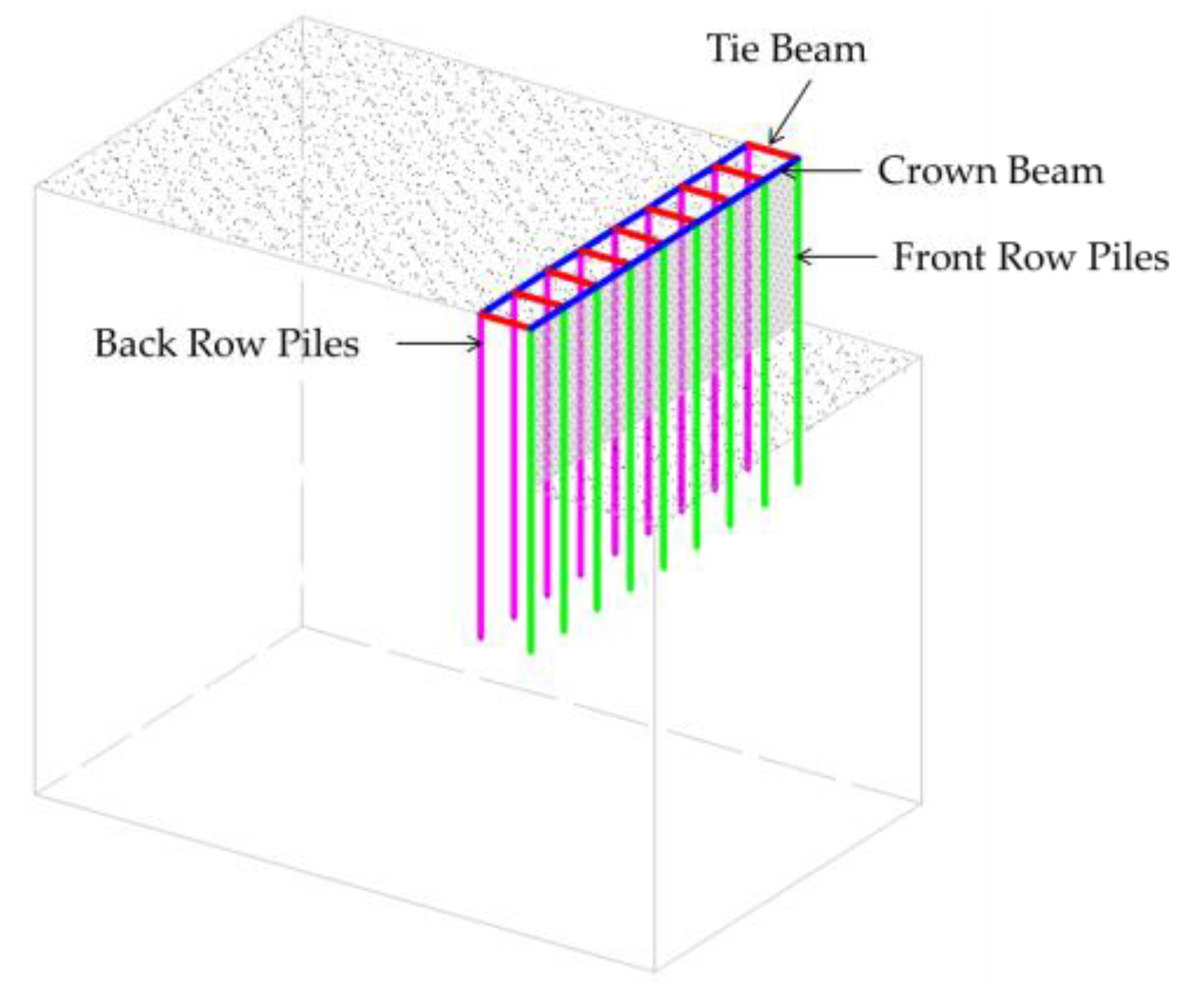




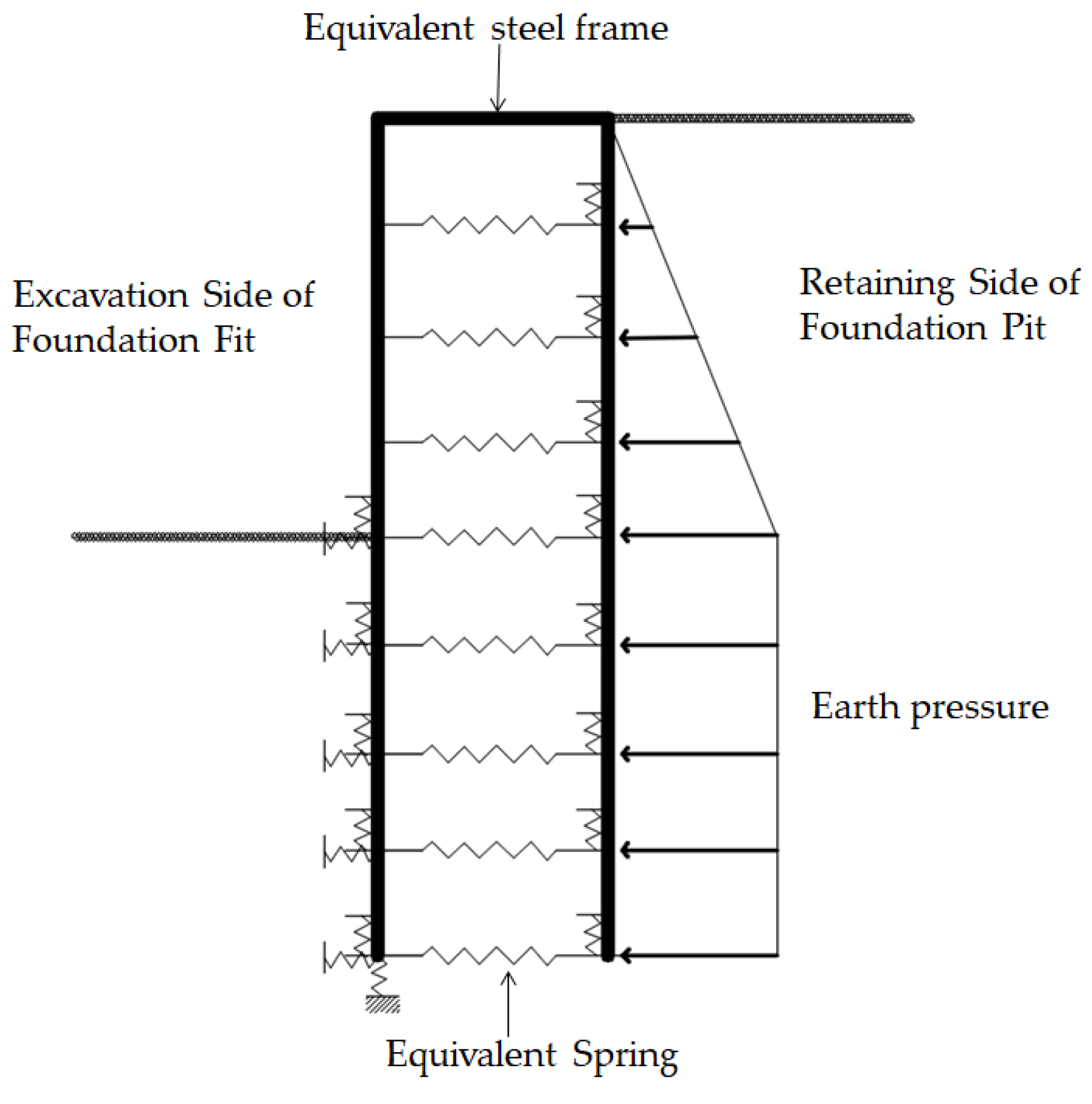
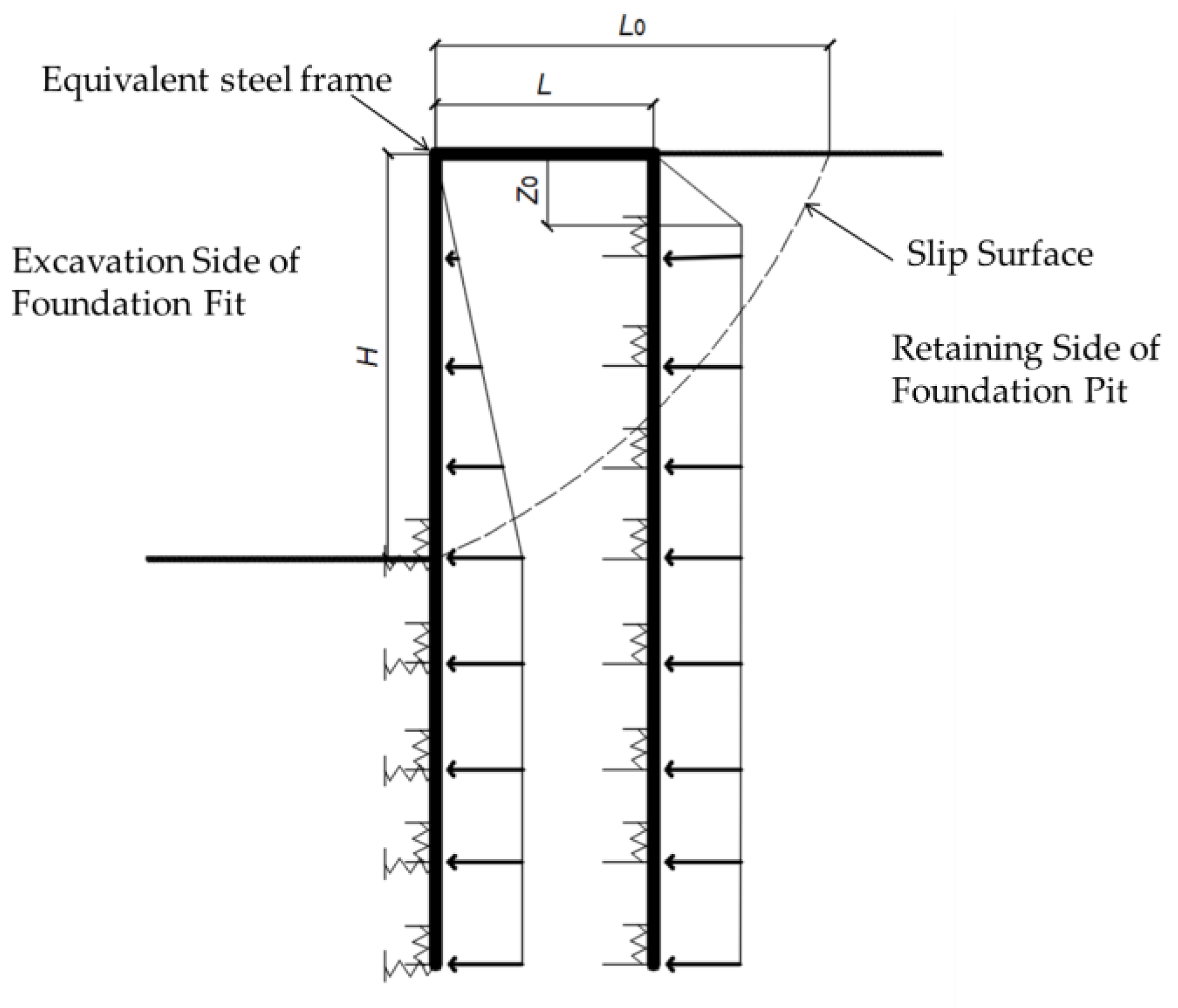
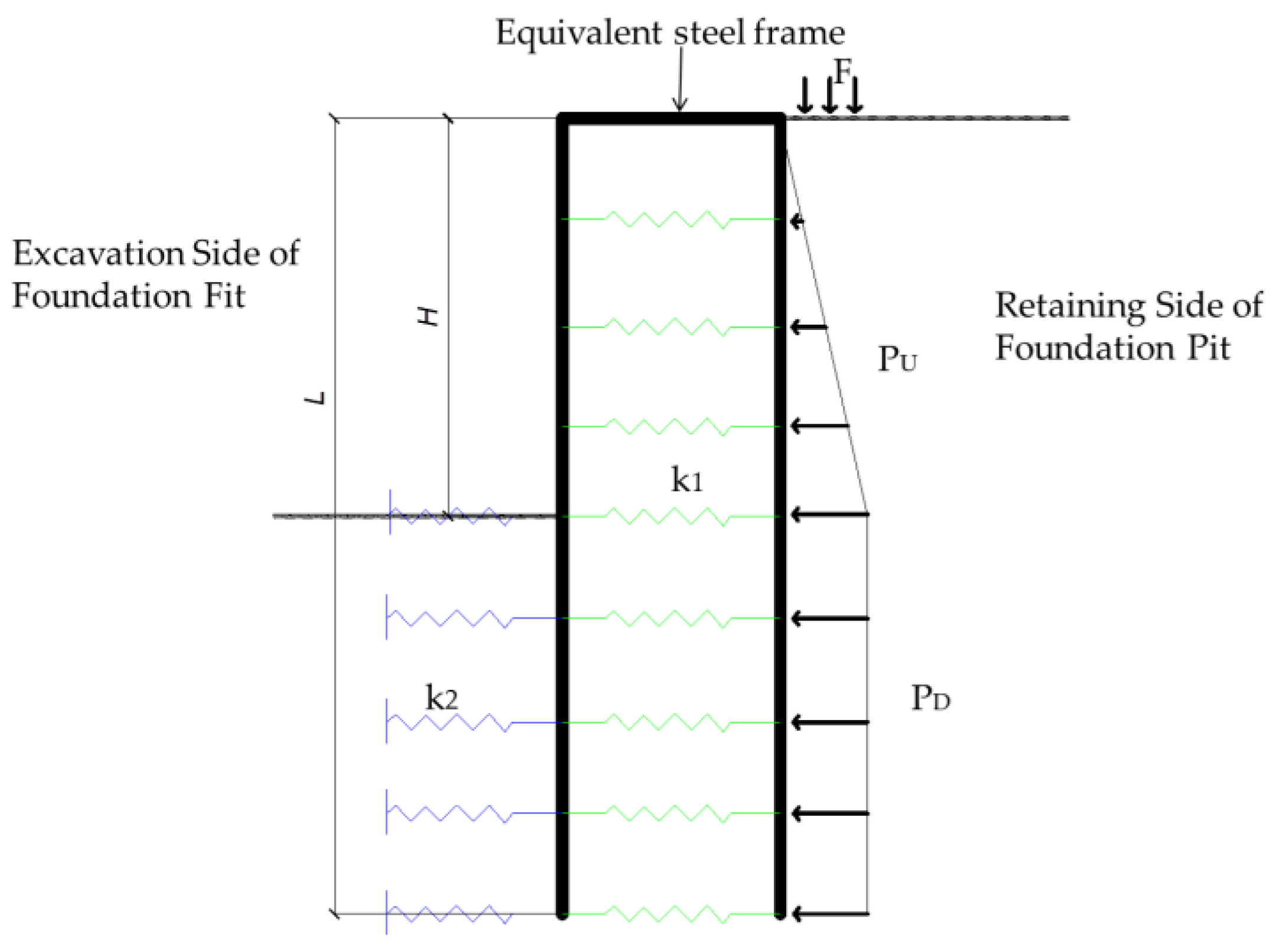
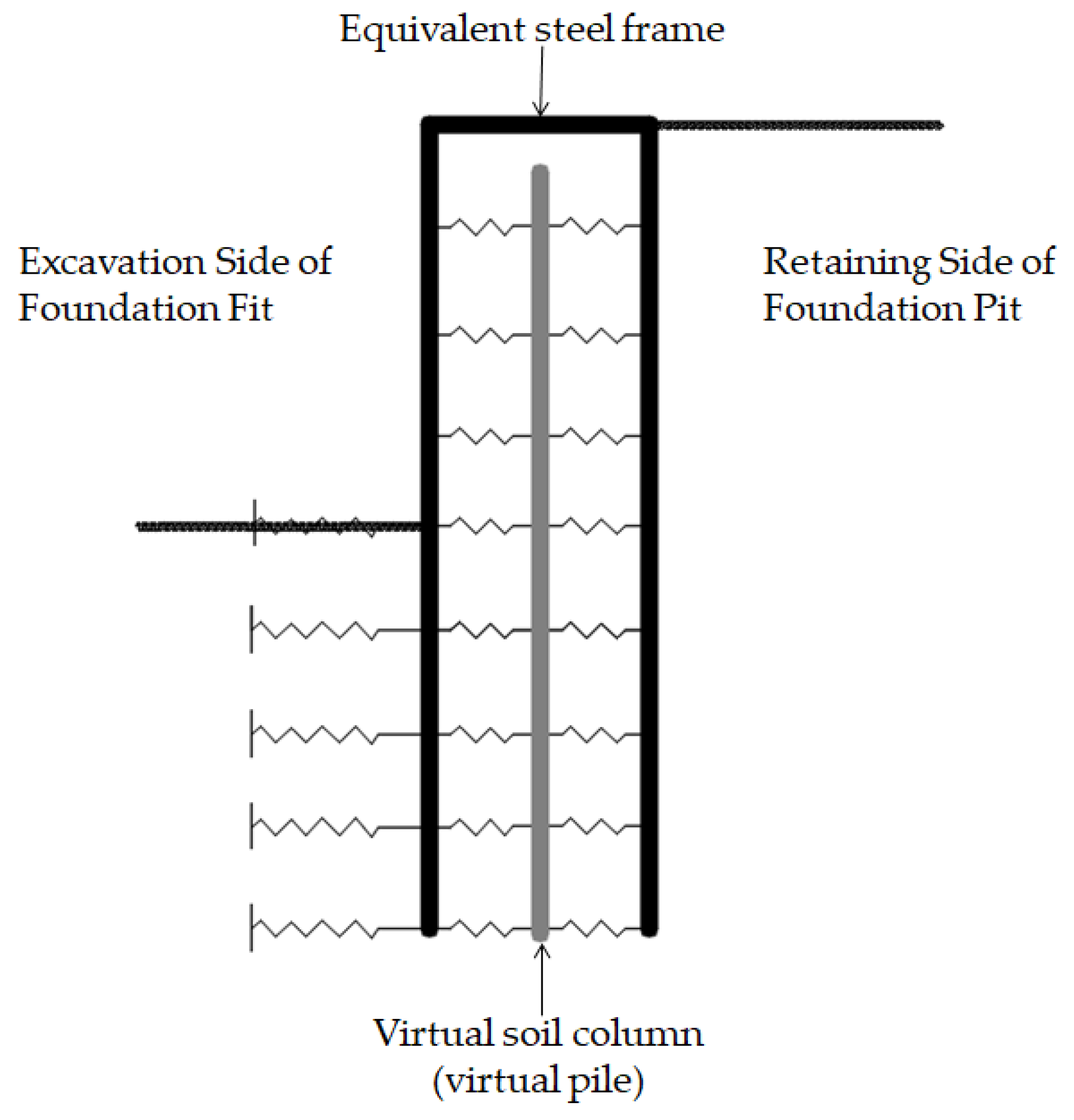
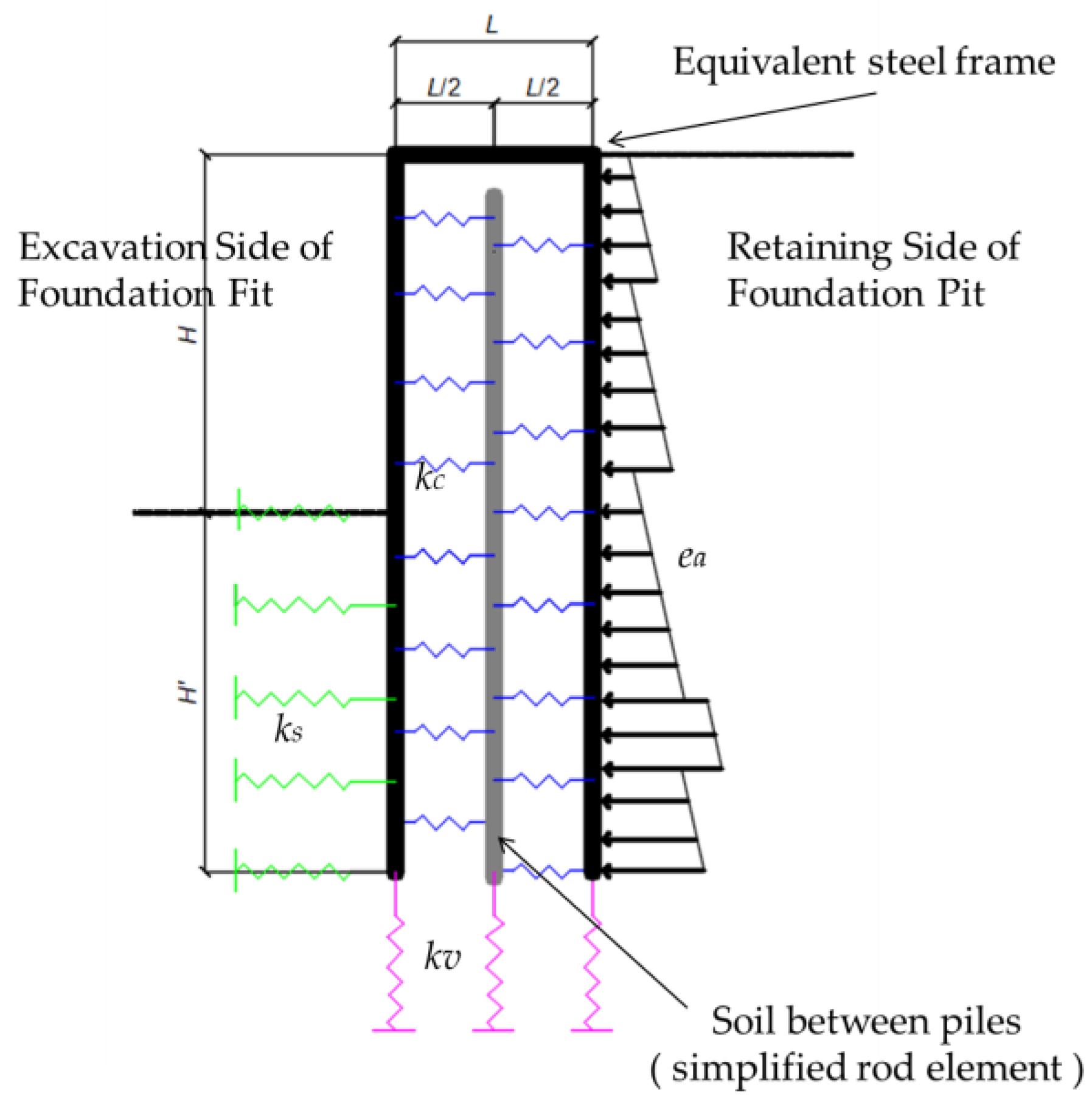

| Pile Type | b* ≤ 1/(m) | b* > 1/(m) |
|---|---|---|
| Rectangular pile | b0 = 1.5b + 0.5 | b0 = b + 1 |
| Circular pile | b0 = 0.9(1.5b + 0.5) | b0 = 0.9(b + 1) |
Disclaimer/Publisher’s Note: The statements, opinions and data contained in all publications are solely those of the individual author(s) and contributor(s) and not of MDPI and/or the editor(s). MDPI and/or the editor(s) disclaim responsibility for any injury to people or property resulting from any ideas, methods, instructions or products referred to in the content. |
© 2023 by the authors. Licensee MDPI, Basel, Switzerland. This article is an open access article distributed under the terms and conditions of the Creative Commons Attribution (CC BY) license (https://creativecommons.org/licenses/by/4.0/).
Share and Cite
Lan, B.; Wang, Y.; Wang, W. Review of the Double-Row Pile Supporting Structure and Its Force and Deformation Characteristics. Appl. Sci. 2023, 13, 7715. https://doi.org/10.3390/app13137715
Lan B, Wang Y, Wang W. Review of the Double-Row Pile Supporting Structure and Its Force and Deformation Characteristics. Applied Sciences. 2023; 13(13):7715. https://doi.org/10.3390/app13137715
Chicago/Turabian StyleLan, Binpeng, Yanping Wang, and Weiguo Wang. 2023. "Review of the Double-Row Pile Supporting Structure and Its Force and Deformation Characteristics" Applied Sciences 13, no. 13: 7715. https://doi.org/10.3390/app13137715
APA StyleLan, B., Wang, Y., & Wang, W. (2023). Review of the Double-Row Pile Supporting Structure and Its Force and Deformation Characteristics. Applied Sciences, 13(13), 7715. https://doi.org/10.3390/app13137715






